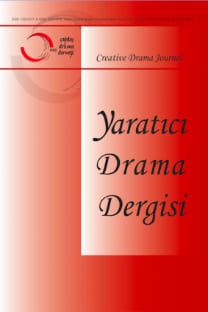Campus Guiding and Creative Drama
Tourist guiding education has some typical problems as a part of tourism education. The primary subjects in the related literature are the qualifications expected from a tourist guide. The curriculum provided in education institutions at university level appear to be inadequate in meeting the sectorial expectations and therefore there are attempts to eliminate such inadequacies through non-curricular activities. These activities; such as projects, practice tours, and workshops take place within or outside of the school days. This paper features a learning process that is aimed for creative drama-based education in the field of tourism, the learning outputs and opinions of the participants; and offers recommendations for drama-based studies in the field of tourist guiding. In the paper, the perceptions, knowledge and attitudes of tourist guiding students were questioned regarding the campus where they study, as a part of a project titled “tourist guiding”, and examined the relations between their lives and the campus history and especially the life of Yunus Emre, after whom the campus has been named, with a reflexive understanding. The creative drama sessions continued for 18 hours and the brochures, newspapers, student diaries, letters and participant opinions generated as a result of the drama process were subjected to descriptive analysis. The obtained findings are grouped under three headings titled positive attitude of students to the campus, effectiveness of the drama experience in the affective field and applicability of drama, together with the creative drama experience.
Anahtar Kelimeler:
Campus guiding, Creative drama, Drama
___
- Adıgüzel, Ö. (2006). Yaşantılara dayalı öğrenme, yaratıcı drama ve süreçsel drama ilişkileri. Yaratıcı Drama Dergisi, 1 (1), 31-39.
- Airey, D. (2013). Forty years of tourism education and research. Poznan University of Economics Review, 13 (4), 11-19.
- Armstrong K. E. (2003). Applications of role-playing in tourism management teaching: An evaluation of a learning method. Journal of Hospitality, Leisure, Sport and Tourism Education, 2 (1), 5-16.
- Boal, A. (1992). Games for actors and non-actors, London: Routledge.
- Bramwell, B. (1998). User satisfaction and product development in urban tourism. Tourism Management, 19(1), 35-47.
- Brennan R. ve Pearce G. (2009). Educational drama: A tool for promoting marketing education?. The International Journal of Management Education, 8 (1), 1-9.
- Broderick A. ve Pearce G. (2001). Indoor adventure training: a dramaturgical approach to management development, Journal of Organizational Change Management, 14 (3), 239-252.
- Caton K. (2014). Underdisciplinarity: Where are the humanities in tourism education?. Journal of Hospitality, Leisure, Sport and Tourism Education, 15, 24-33.
- Csikszentmihalyi, M. (1990). Flow: The psychology of optimal experience, New York: Harper and Row.
- Freire, P. (1970). Pedagogy of the oppressed, New York: Continuum.
- Inui Y., Wheeler D. ve Lankford S. (2006). Rethinking tourism education? What should schools teach?. Journal of Hospitality, Leisure, Sport and Tourism Education, 5(2), 25-35.
- Mccaslin, N. (2006). Creative drama in the classroom and beyond, (8th Edition), Pearson.
- O’Neil, C. ve Lambert A. (1991). Drama structures: a practical handbook for teachers, Portsmouth: Heinemann.
- Okoronkwo S. (2011). Creative Dramatics As An Effective Educational Tool In Contemporary Education: A Pedagogical Discourse, Proceedings of the 2011 International Conference on Teaching, Learning and Change, Konferans web sitesinden 30 Aralık 2018 tarihinde erişildi:+ http://hrmars.com/admin/pics/112.pdf
- Pearce G. (2003). How university students studying marketing learn from educational drama, NJ Drama Australia Journal, 27 (1), 69-80.
- Pearce G. (2006). University student perceptions of the difference between educational drama and other types of educational experiences, Marketing Education Review, 16 (2), 23-35.
- Pearce G. ve Hardiman N. (2012). Teaching undergraduate marketing students using ‘hot seating through puppetry’: An exploratory study, Innovations in Education and Teaching International, 49 (4) , 437-447.
- San, İ. (1996).Yaratıcılığı geliştiren bir yöntem ve yaratıcı bireyi yetiştiren bir disiplin: eğitsel yaratıcı drama. Yeni Türkiye Dergisi, 2 (7), 148-160.
- Swale J. (2009) Drama games for classrooms and workshops, London: Nick Hern Books.
- Toivanena, T., Komulainena K. ve Ruismäkia H. (2011) Drama education and improvisation as a resource of teacher student’s creativity. International Conference on Education and Educational Psychology (ICEEPSY 2010), Procedia Social and Behavioral Sciences, 12, 60–69.
- Üstündağ, T. (1997) The advantages of using drama as a method of education ın elementary schools, Hacettepe Üniversitesi Eğitim Fakültesi Dergisi, 13, 89-94.
- Westrup, U. ve Planander, A. (2013). Role-play as a pedagogical method to prepare students for practice: The students’ voice. Högre Utbildning, 3(3), 199-210.
- Yıldırım A. ve Şimşek H. (2011). Sosyal bilimlerde nitel araştırma yöntemleri, Ankara: Seçkin Yayıncılık.
- ISSN: 1305-8177
- Başlangıç: 2006
- Yayıncı: Gençlik Kulübu ve Çağdaş Drama Derneği
Sayıdaki Diğer Makaleler
Fen Eğitiminde Yaratıcı Drama Yönteminin Başarıya Etkisi: Meta-Analiz Çalışması
Pınar ÖZDEMİR ŞİMŞEK, Fatma Zehra KARATAŞ
Yaratıcı Drama Yönteminin HIV/AIDS’e İlişkin Farkındalığa Etkisi
Campus Guiding and Creative Drama
Naime EREN, Derya ATALAN ERGİN, Cemre TATLI
Çocuk Sanat Kitapları Nasıl Değerlendirilmeli? Biçim ve İçerik Bağlamında Bir İnceleme Örneği
